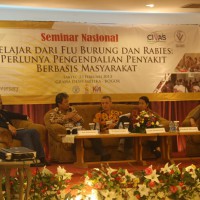CIVAS 8th Anniversary: Seminar on “The Global Threat of Antimicrobial Resistance: How Should We Act?”
Sunday, 23 March 2014
Universitas Siswa Bangsa Internasional, Jakarta, Saturday, March 22, 2014
The use of antimicrobial for the treatment of infectious diseases has grown rapidly since the 19th century. Such development was followed by the increase of antimicrobial resistance. Every year 2 million people in the United State are infected by resistant bacteria resistant and at least 23.000 people die as a result of the infection (Center for Disease Control and Prevention/ CDC Report in 2013). Antimicrobial resistance has become a global health issues.
One contributor to the increase of antimicrobial resistance is the irrational use of antimicrobial in humans and animals. Fundamentally, resistance in humans could not be separated from the development of antimicrobial resistance in animals, particularly with the use of sub-therapeutic levels of antibiotic growth promoter (AGP) in feed which leads to the development of resistant bacteria populations. Therefore in 2011, WHO issued several strategies and recommendations to control antimicrobial resistance in humans. In 2012, OIE also released recommendations to control antimicrobial resistance in animal health and animal husbandry practices.
As an effort to raise awareness on this global issue and celebrate its 8th anniversary, the Center for Indonesian Veterinary Analytical Studies (CIVAS) conducted a National Seminar on “The Global Threat of Antimicrobial Resistance: How Should We Act?” on Saturday, March 22, 2014, at the Auditourium of Universitas Siswa Bangsa Internasional, Mulia Business Park Building 1st floor, Jl. M. T. Haryono No. Kav. 58-60 Pancoran, Jakarta. The seminar was aimed to increase knowledge and understanding of antimicrobial resistance and its current situation in the world, the region and in Indonesia, increase awareness on the prudent use of antimicrobials, and gather information necessary to encourage and support the making, development, use, and enforcement of rules/policies related to antimicrobial control in Indonesia. The seminar was also intended to be a forum for information exchange on antimicrobial resistance status in Indonesia and initiate and reactivate the involvement of various stakeholders from all sectors, e.g. production policies, distribution, usage and study, and control and monitoring, related to antimicrobial use in order to achieve a global health for human, animal, and the environment. This seminar was supported by The American Institute for Indonesia Studies (AIFIS), a non-government organization focused on education, particularly at university level, information exchange and issues related to science and social culture.
The seminar presented four (4) speakers, which are :
- Prof. Dr. Pratiwi P. Sudarmono, PhD, SpMK (K), Vice Dean of the Faculty of Medicine, University of Indonesia, with topic “Multidrug-Resistant Bacteria to Antibiotics: a Global Problem”.
- Drh. Tri Satya Putri Naipospos, MPhil, PhD, Chair of the Directive Board of CIVAS, with a topic “Antimicrobial Resistance in Animals: A Perspective on Global Livestock Production and Correlations with Antimicrobial Usage”.
- Drh. Akhmad Junaidi, MMA, Director of Veterinary Public Health, Directorate General of Livestock and Animal Health Services (DGLAHS), Ministry of Agriculture, with a topic “The Threat of Antimicrobial Resistance: Impact of Drug Use in Food Products of Animal Origin”.
- Dr. Siswanto, MPH, DTM, Head of the Center of Applied Health Technology and Clinical Epidemiology, Health Research and Development Agency, Ministry of Health, with topic “Study of Antimicrobial Resistance in Humans in Indonesia”.
The seminar was led by Dr. Med. Vet. Drh. Hadri Latif, MSi, a professor of Veterinary Public Health at the Department of Animal Disease and Veterinary Public Health, Faculty of Veterinary Medicine, Bogor Agricultural University, and Member of the Directive Board of CIVAS.
The seminar was conducted from 09.00 AM until 02.00 PM, preceded with a speech from the Executive Director of CIVAS, Drh. M. D. Winda Widyastuti, MSi, Chairman of the Directive Board of CIVAS, Drh. Tri Satya P. Naipospos, MPhil, PhD, and finally Drh. Pudjiatmoko, PhD, Director of Animal Health, who officially opened the seminar.
The seminar was attended by 114 participants from the Health Research and Development Agency (Balitbangkes), Sub-Directorate of Zoonosis – Directorate of Zoonotic Disease Control – Directorate General of Diseases Control and Environmental Health, Directorate of Pharmaceutics Development Services and Health Tools (Bina Yanfar dan Alkes) , Directorate of Medical Support Services, Directorate General of Health Education – Ministry of Health Republic of Indonesia, Agriculture Quarantine Agency, Center of Social Economic and Agricultural Policy (PSEKP), Directorate of Veterinary Public Health and Post Production, Directorate of Animal Health, Center for Quality Control and Veterinary Drug Certification (BBPMSOH), Center for Veterinary Research, Center for Quality Control and Animal Product Certification (BPMSPH), Disease Investigation Center Wates, Disease Investigation Center Denpasar, Disease Investigation Center Bandar Lampung, Disease Investigation Center Subang, Disease Investigation Center Banjarbaru, Center for Livestock Research Ciawi-Bogor – Ministry of Agriculture RI, Marine and Agriculture Service Office of DKI Jakarta Province, Livestock and Fisheries Service Suboffice of East Jakarta, Livestock and Fisheries Service Suboffice of South Jakarta, Livestock and Fisheries Service Suboffice of Bogor District, Agriculture Service Office of Bogor City, Agriculture Service Office of Tangerang City, Agriculture and Livestock Service Office of Tangerang District, Livestock and Animal Health Service Office of Central Java Province, Poltekes Banten, Indonesia Young Entrepreneurs - Moderator Anggota Jaringan Komunikasi Masyarakat Peduli Perikanan, Pertanian dan Peternakan (JKMP4), Transfarma Medica, PT. Agri Trading Investment, Japfa Santori, PT. Sehat Cerah Indonesia, Zen Pet Clinic, Sumber Unggas, graduate students, postgraduate students, and DVM students from Bogor Agricultural University, USBI students, and partners from the media, i.e. Trobos Magazine and Agrina Tabloid.
Results of the seminar were amalgamated by Dr. Drh. Anak Agung Gde Putra, SH, MSc, PhD, Drh. Pebi Purwo Suseno and Drh. Imron Suandy, MVPH into a set of recommendations. The recommendations were presented in the last session for final comments and finalization.
The recommendations are (Attached):
- Antimicrobial resistance is a threat to public health, animal health, and environmental health.
- Antimicrobial resistance can occur naturally or be acquired from certain risk factors.
- Factors contributing to the development of antimicrobial resistance are:
- Poor implementation of antimicrobial usage guidelines.
- Lack of control in antimicrobial sale, distribution, and use.
- The absence of a national surveillance program for antimicrobial resistance.
- Inadequate data analysis of antimicrobial resistance test results.
- Insufficient quality assurance in laboratories conducting antimicrobial resistance testing
- In the livestock sector, antimicrobial resistance is driven by the increasing demand for animal products. Industrialization and the desire to increase productivity gave rise to extensive and uncontrolled use of antimicrobial drugs for treatment and growth promoters.
- In human, important factors contributing to antimicrobial resistance are inappropriate use of antibiotics (against prescription), free access to antibiotics, inappropriate self-medication, and irrational use of antibiotics.
- In the environment, increasing environmental pollution by the remnants of antibiotics from poor sanitary and biosecurity practices or antibiotic residues leads to the development of resistant bacteria in the environment. These resistant bacteria can transfer resistant genes other bacteria, commensal or pathogen.
- Antimicrobial resistance can result in the failure of standard therapy/treatment, increased cost and risk of death.
- Antimicrobial resistance is a public health, animal health, and environment health problem, therefore a multi-sector strategy and approach is needed for its prevention and control.
- Recommendations from the World Organization for Animal Health (OIE) for antimicrobial usage in animal health are:
- Enforce rules, guidelines and standards on antimicrobial use and government regulations for better control of antimicrobial production, registration, distribution, and use.
- Better knowledge and monitoring on the quantity of antimicrobials used in livestock production.
- Synchronize national surveillance programs and monitoring of antimicrobial resistance incidents in animals, human and the environment, and international coordination and solidarity programs for developing countries.
- Implementation of risk assessments.
- Prevention of hazardous practices.
- Legal punishment for parties involved in the production and distribution of counterfeit drugs.
- The strategy and action for antimicrobial resistance prevention and mitigation is:
- Develop and/or refine guidelines and regulations related to antimicrobial use.
- Build and increase the capacity of test laboratories.
- Develop and strengthen antibiotic surveillance networks in each sector and between animal and human health sectors, including laboratories, technical units, public and private sectors, and educational institutions or universities.
- Establish a sound and sustainable monitoring and evaluation program for antimicrobial permits, distribution and use.
- Joint research between animal health and human health sectors, optimize supervision of research programs, and improve the dissemination system of various studies or information/knowledge exchange through workshops, conferences, communication forums and cross-sector working groups.
- Encourage attitude and behaviour change through information dissemination and knowledge and awareness improvement of various stakeholders on the importance of rational antimicrobial use.
- Develop a multi-sector national roadmap for antimicrobials resistance mitigation.
Implementation of the national strategy for antimicrobial resistance control must involve participation and commitment from all stakeholders (government, farmers, pharmaceutical companies, drug importers, livestock associations, pharmaceutical associations, and other stakeholders) for the success of law enforcement.








